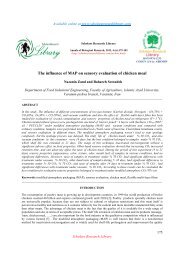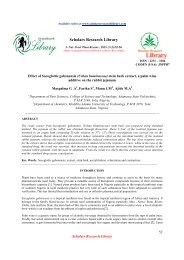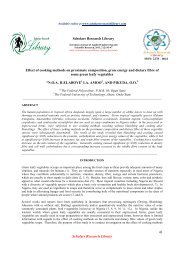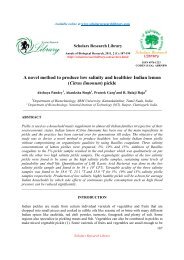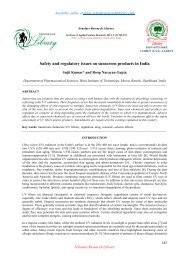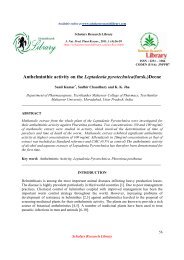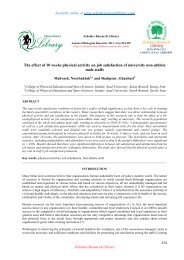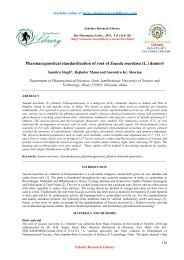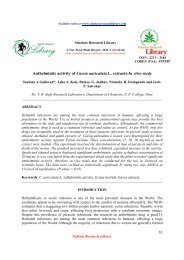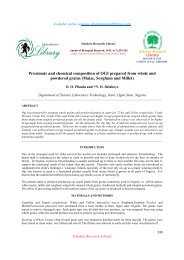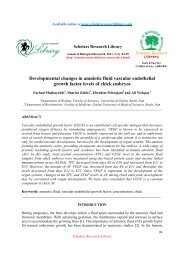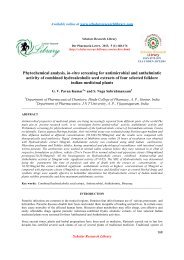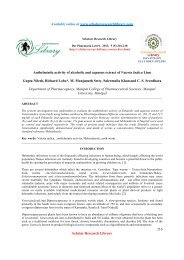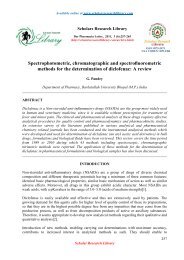Regulation for safety and quality of cosmetics vis - Scholars ...
Regulation for safety and quality of cosmetics vis - Scholars ...
Regulation for safety and quality of cosmetics vis - Scholars ...
Create successful ePaper yourself
Turn your PDF publications into a flip-book with our unique Google optimized e-Paper software.
Available online at www.scholarsresearchlibrary.com<br />
<strong>Scholars</strong> Research Library<br />
Der Pharmacia Lettre, 2012, 4 (1):181-191<br />
(http://scholarsresearchlibrary.com/archive.html)<br />
Scholar Research Library<br />
ISSN 0975-5071<br />
USA CODEN: DPLEB4<br />
<strong>Regulation</strong> <strong>for</strong> <strong>safety</strong> <strong>and</strong> <strong>quality</strong> <strong>of</strong> <strong>cosmetics</strong> <strong>vis</strong>-a-<strong>vis</strong> colourants in<br />
India compared with other nations<br />
Sujit Kumar* <strong>and</strong> Roop Narayan Gupta<br />
Department <strong>of</strong> Pharmaceutical Sciences, Birla Institute <strong>of</strong> Technology, Mesra, Ranchi,<br />
Jharkh<strong>and</strong>, India<br />
______________________________________________________________________________<br />
ABSTRACT<br />
Cosmetics market has been increasing tremendously in the world <strong>and</strong> colourants are one <strong>of</strong> the<br />
most popular ingredients in cosmetic products providing a way in which a person can change his<br />
or her appearance <strong>and</strong> make the product instantly noticeable <strong>and</strong> attractable <strong>for</strong> purchase.<br />
Labelling, nomenclature <strong>and</strong> <strong>safety</strong> <strong>of</strong> colourants vary in different countries. Robust legislation<br />
exists in the European Union (EU) <strong>and</strong> the United States <strong>of</strong> America (USA) to regulate their use<br />
<strong>for</strong> cosmetic products. Variations in regulations affect <strong>safety</strong> assessments <strong>of</strong> cosmetic products.<br />
Indian regulation requires improvement <strong>and</strong> harmonization with international regulations. In the<br />
present article, we examine <strong>and</strong> establish the need <strong>for</strong> harmonisation <strong>of</strong> regulations <strong>for</strong><br />
colourants.<br />
Key words: Colourants, legislation, regulation, labelling, nomenclature, <strong>safety</strong><br />
______________________________________________________________________________<br />
INTRODUCTION<br />
In both the United States <strong>of</strong> America (USA) <strong>and</strong> the European Union (EU) <strong>cosmetics</strong><br />
manufacturers ensure product <strong>safety</strong> prior to marketing. All the ingredients are listed on the<br />
product label <strong>and</strong> comply with any restrictions that are established <strong>for</strong> cosmetic ingredients <strong>and</strong><br />
products. Colour additives are subject to more regulatory scrutiny in the US than they are in<br />
Europe. In USA, the Cosmetic Ingredient Review (CIR) expert panel conducts independent<br />
<strong>safety</strong> reviews <strong>of</strong> ingredients as a part <strong>of</strong> the <strong>cosmetics</strong> <strong>safety</strong> process, with the results published<br />
in the International Journal <strong>of</strong> Toxicology <strong>and</strong> on the CIR website. The EU Scientific Committee<br />
on Consumer <strong>safety</strong> is responsible <strong>for</strong> reviewing all special <strong>and</strong> active ingredients <strong>and</strong> assessing<br />
conditions <strong>for</strong> safe use. The results are subsequently published in the Committee’s website [1].<br />
Europe <strong>and</strong> USA are the largest markets in the world <strong>for</strong> cosmetic products. In the end user<br />
segments, decorative <strong>cosmetics</strong> (that modify the appearance <strong>of</strong> the area to which they are<br />
applied, usually by the use <strong>of</strong> colour, examples are: lipstick, eye shadow, blusher, eye pencil,<br />
liquid foundation, powder, mascara, nail polish etc.) have the highest average annual growth rate .<br />
The <strong>cosmetics</strong> market in India is growing at 15-20% annually, twice as fast as the USA <strong>and</strong> EU<br />
181
Sujit Kumar et al Der Pharmacia Lettre, 2012, 4 (1):181-191<br />
_____________________________________________________________________________<br />
market. Indian cosmetic industries continue to be a beautiful blend <strong>of</strong> traditional <strong>and</strong> modern like<br />
kajal, sindoor, kum-kum, herbal <strong>cosmetics</strong>, lipsticks, nail polishes etc. The aim <strong>of</strong> the present<br />
article is to compare the regulations in EU, USA, Canada, ASEAN nations <strong>and</strong> India <strong>for</strong><br />
cosmetic colourants with respect to labelling, nomenclature, <strong>safety</strong> <strong>and</strong> thereby <strong>quality</strong> <strong>of</strong> the<br />
products to the end users <strong>and</strong> includes the following aspects.<br />
COSMETICS COLOUR LABELLING<br />
EU<br />
In the EU, the regulatory framework is provided by the Cosmetics Directive (76/768/EEC) <strong>and</strong><br />
its subsequent amendments. Colouring agents may be listed in any order after the other<br />
ingredients using the Colour Index Number or denomination adopted in Annex IV. For<br />
decorative <strong>cosmetics</strong> marketed in several colour shades, all colouring agents used in the range<br />
may be listed preceded by the words “may contain” or the symbol “+/-” [2, 3].<br />
The <strong>Regulation</strong>s make pro<strong>vis</strong>ion <strong>for</strong> the listing <strong>of</strong> all colouring agents used in a decorative<br />
<strong>cosmetics</strong> although each product would only contain a selection <strong>of</strong> those colours. The intention is<br />
to simplify manufacture by allowing all <strong>of</strong> the colouring agents to be listed on one label in a<br />
market where fashions <strong>and</strong> colours change frequently. Ingredient listing is required on the outer<br />
packaging only or, in its absence, on the primary container. Where it is impossible <strong>for</strong> practical<br />
reasons <strong>for</strong> the list to appear on the packaging (or container), it is required to be given on a<br />
leaflet, label, tag, tape or card enclosed with the product or attached to it. Colour ingredients<br />
which do not have a CI number, <strong>and</strong> not listed in the above <strong>Regulation</strong>s, but are closely<br />
associated with colour might only be present in some products within the decorative range.<br />
These items are mentioned under the +/- (may contain) section <strong>of</strong> the ingredient listing like mica<br />
<strong>and</strong> tin oxide, both used as opacifiers.<br />
US<br />
The cosmetic product ingredients labelling are regulated by the Federal Food, Drug <strong>and</strong><br />
Cosmetic Act, as amended (FFDCA) <strong>and</strong> its implementing regulations. The Fair Packaging <strong>and</strong><br />
labelling Act, as amended (FPLA) <strong>and</strong> its implementing regulations are also considered.<br />
Ingredients other than colours present at a concentration exceeding 1% in descending order or<br />
predominance, followed by ingredients other than colours present at 1% or less in any order,<br />
followed by colours present at any concentration listed in any order. The colour additives<br />
common to all shades must be listed be<strong>for</strong>e “May contain”, <strong>and</strong> only those not found in all shade<br />
<strong>for</strong>mulations may be listed after “May contain” [4].<br />
FFDCA defines a colour additive as a material which –(a) is a dye, pigment or other substance<br />
made by a process <strong>of</strong> synthesis or similar artifice, or extracted, isolated or otherwise derived,<br />
with or without immediate or final change <strong>of</strong> identity, from a vegetable, animal, mineral or other<br />
source, <strong>and</strong> (b) when added or applied to a food, drug or cosmetic, or to the human body or any<br />
part there<strong>of</strong>, is capable (alone or through reaction with other substance) <strong>of</strong> imparting colour<br />
thereto.......The term colour includes black, white <strong>and</strong> intermediate grays.<br />
ASEAN<br />
ASEAN (Association <strong>of</strong> South East Asian Nations) nations, a group <strong>of</strong> ten countries, follow<br />
ASEAN Cosmetic Directive which defines “colour” as a substance used as an ingredient <strong>of</strong><br />
cosmetic product solely to give tonality to the product. Variants are defined (a range <strong>of</strong> cosmetic<br />
products) as similar in composition but differs in colours, flavours etc. - produced by the same<br />
manufacturer, <strong>and</strong> are intended <strong>for</strong> the same use but are available in different shades <strong>of</strong> colour<br />
(e.g. lipsticks, eye shadows or nail polish but not composite packs <strong>of</strong> different types). These are<br />
Scholar Research Library<br />
182
Sujit Kumar et al Der Pharmacia Lettre, 2012, 4 (1):181-191<br />
_____________________________________________________________________________<br />
considered as different types <strong>of</strong> products. Member States adopt the Cosmetic Ingredient Listings<br />
<strong>of</strong> the EU Cosmetic Directive 76/768/EEC including the latest amendments [5].<br />
CANADA<br />
The basis <strong>for</strong> the regulatory authority <strong>for</strong> the Cosmetics Program comes from the Food <strong>and</strong><br />
Drugs Act <strong>and</strong> Cosmetic <strong>Regulation</strong>s [10]. Ingredient is defined as any substance that is one <strong>of</strong><br />
the components <strong>of</strong> a cosmetic <strong>and</strong> includes colouring agents, botanicals, fragrance <strong>and</strong> flavour,<br />
but does not include substances that are used in the preparation <strong>of</strong> the cosmetic but that are not<br />
present in the final product as a result <strong>of</strong> the chemical process [6].<br />
All colouring agents, regardless <strong>of</strong> their concentration, may be listed in r<strong>and</strong>om order after the<br />
ingredients that are present at a concentration <strong>of</strong> more than 1% (as described in section 21.4(2) <strong>of</strong><br />
the Cosmetic <strong>Regulation</strong>s). It is also acceptable to list colouring agents in descending order <strong>of</strong><br />
predominance.<br />
For make-up products (e.g. lipstick, blush, eye shadow), nail polish <strong>and</strong> nail enamel, which are<br />
sold in a range <strong>of</strong> colour shades, all colouring agents used in the range may be listed if they are<br />
preceded by the symbol "+/-" or "±" or the phrase "may contain/peut contenir" (as described in<br />
section 21.2(2) <strong>of</strong> the Cosmetic <strong>Regulation</strong>s). It is unacceptable to use this notation <strong>for</strong> other<br />
cosmetic products, such as hair dyes [7].<br />
INDIA<br />
Cosmetics products in India is regulated under the Drugs <strong>and</strong> <strong>cosmetics</strong> Act 1940 <strong>and</strong> Rules<br />
1945. BIS (Bureau <strong>of</strong> Indian st<strong>and</strong>ards) sets the st<strong>and</strong>ards <strong>for</strong> <strong>cosmetics</strong> <strong>for</strong> the products listed<br />
under Schedule ‘S’ <strong>of</strong> the Drugs <strong>and</strong> <strong>cosmetics</strong> Rules 1945.<br />
Rule 148(7) <strong>of</strong> the Drugs <strong>and</strong> <strong>cosmetics</strong> Rules 1945 makes pro<strong>vis</strong>ion <strong>for</strong> listing <strong>of</strong> ingredients<br />
present in concentration <strong>of</strong> more than 1% shall be listed in the descending order <strong>of</strong> weight or<br />
volume at the time they are added, followed by those in concentration <strong>of</strong> less than or equal to 1%<br />
in any order <strong>and</strong> preceded by word “ingredients”......provided that this statement need not appear<br />
<strong>for</strong> packs <strong>of</strong> less than 60ml <strong>of</strong> liquids <strong>and</strong> 30gm <strong>of</strong> solid <strong>and</strong> semisolid [8].<br />
NOMENCLATURE OF COLOURS<br />
Identification <strong>of</strong> the colour additives on cosmetic product labels has been a discussion item <strong>for</strong><br />
many years between different regulatory bodies <strong>and</strong> the industry. There should be a simpler <strong>and</strong><br />
uni<strong>for</strong>m system <strong>of</strong> identifying these colour additives, one that could be used world-wide so that<br />
all cosmetic products use the same terminology <strong>for</strong> the same basic ingredients.<br />
EU<br />
For colouring agents use <strong>of</strong> INCI names is recommended. EEC directive mentions that colouring<br />
agents may be listed in any order after the other ingredients using the Colour Index (CI) Number<br />
or denomination adopted in annex IV [3].<br />
US<br />
The <strong>of</strong>ficial names <strong>for</strong> colour additives in the USA are designated by FDA [9]. Colours subject to<br />
batch certification are designated as food, drugs <strong>and</strong> <strong>cosmetics</strong> (FD&C), drugs <strong>and</strong> <strong>cosmetics</strong><br />
(D&C) or external drugs <strong>and</strong> <strong>cosmetics</strong> (Ext. D&C). This is followed by a colour designation,<br />
such as blue or red, <strong>and</strong> by No. (<strong>for</strong> number), <strong>and</strong> by a numeral. An example <strong>of</strong> such a name is<br />
FD&C Red No. 40. Colours made by combining these "straight" colours with "substrates"<br />
Scholar Research Library<br />
183
Sujit Kumar et al Der Pharmacia Lettre, 2012, 4 (1):181-191<br />
_____________________________________________________________________________<br />
(sodium, potassium, aluminium, barium, calcium strontium, or zirconium) are known as "lakes"<br />
<strong>and</strong> are named using the same convention, but with the addition <strong>of</strong> the word lake <strong>and</strong> the<br />
substrate, <strong>for</strong> example: FD&C Red No. 40 Aluminium Lake. Cosmetic colours that are not<br />
subject to batch certification are known by more common names, <strong>for</strong> example: Caramel or<br />
Henna. The important thing to note is that all <strong>of</strong> these colours, both those that are subject to batch<br />
certification <strong>and</strong> those that are not, must be pre-approved, <strong>and</strong> have specifications set, be<strong>for</strong>e<br />
being used in cosmetic products in the USA. FDA also allows companies marketing their<br />
products internationally to use dual labelling <strong>for</strong> colours, listing names acceptable to the FDA as<br />
well as Colour Index (CI) numbers that are required <strong>for</strong> labelling colours in the European Union<br />
<strong>and</strong> other countries in the world. Thus, <strong>for</strong> example, a cosmetic product in the USA may bear<br />
ingredient labelling <strong>for</strong> colours such as Yellow 5/CI 19140 or FD&C Yellow No. 5/CI 19140 [9].<br />
The FDA has granted permission <strong>for</strong> the cosmetic industry to use abbreviated names on the<br />
labels <strong>of</strong> products containing the certifiable colours or lakes. For example, FD&C Blue No. 1<br />
now may be listed as Blue 1, <strong>and</strong> FD&C Red No. 40 Aluminium Lake may now be listed as Red<br />
40 Lake. The original colour names also may still be used.<br />
INDIA<br />
Rule 127 clause (2) <strong>of</strong> the Drugs <strong>and</strong> Cosmetics Rules 1945 mentions that the label on the<br />
container <strong>of</strong> a drug containing a permitted colour shall indicate the common name <strong>of</strong> the colour,<br />
<strong>for</strong> example: Quinazarine Green SS, Tartrazine, Erythrosine etc. But, the same is not true with<br />
<strong>cosmetics</strong>. No direction is given in the D&C Act <strong>and</strong> Rules regarding the nomenclature <strong>of</strong> a<br />
colouring agent.<br />
Pond’s White Beauty cream (Hindustan Unilever Ltd.) mentions CI 14700 on the label. Garnier<br />
Wrinkle Lift anti-ageing cream (Loreal India Pvt. Ltd.) does not mention any colour. Lactocalamine<br />
(Nicholas Piramal India Ltd.) mentions the colour on the label as “permitted colour”.<br />
New Ever Youth Orange Peel Off Skin Vitalizer (Cadila Healthcare Ltd.) doesot mention any<br />
colour. Artistry essentials polishing scrub (imported by Amway India Enterprises Pvt. Ltd.)<br />
mentions the colour as ultramarines. Glister toothpaste (manufactured by Sarvottam Care, India<br />
<strong>for</strong> Amway India Enterprises Pvt. Ltd.) mentions the colour as FD&C Blue No 1(CI<br />
42090).These examples prove that there is no harmonization in the nomenclature <strong>of</strong> colourants in<br />
India. Table I, compares the names <strong>of</strong> the colour additives used by USA <strong>and</strong> Indian regulation.<br />
SAFETY ISSUES<br />
EU<br />
In EU the <strong>safety</strong> <strong>of</strong> <strong>cosmetics</strong> is covered by the EC Cosmetics Directive (76/768/EEC) as<br />
amended. Annex IV to Cosmetics Directive 76/768/EEC provides <strong>for</strong> a “list <strong>of</strong> colouring agents<br />
allowed <strong>for</strong> use in cosmetic products”. The allowed use refers to different fields <strong>of</strong> applications<br />
[10]. This is implemented in UK by the Cosmetic Products (Safety) <strong>Regulation</strong>s 2008 [11]. Mica<br />
is not considered a colourant in EU <strong>and</strong> Japan. Aluminium colourants are approved <strong>for</strong> all<br />
cosmetic applications in EU <strong>and</strong> Japan. Ferric ferrocyanide may be used in externally applied<br />
<strong>cosmetics</strong> in addition to the lip area use in EU <strong>and</strong> Japan.<br />
Scholar Research Library<br />
184
Sujit Kumar et al Der Pharmacia Lettre, 2012, 4 (1):181-191<br />
_____________________________________________________________________________<br />
Table I<br />
Colour Index No. Colour<br />
USA INDIA<br />
10316 Ext yellow 7 Yellow<br />
12085 Red 36 Red<br />
20170 Brown 1 Orange<br />
40800 β-carotene Orange<br />
60730 Ext violet 2 Violet<br />
75120 Annatto Orange<br />
75130 β-carotene Orange<br />
75170 Guanine White<br />
75470 Carmine Red<br />
75810 Chlorophyllin-copper complex Green<br />
77000 Aluminium powder White<br />
77007 Ultramarines Blue<br />
77163 Bismuth oxychloride White<br />
77288 Chromium oxide Green<br />
77400 Bronze powder Brown<br />
77489<br />
Orange<br />
77491 Red<br />
77492 Iron oxides<br />
Yellow<br />
77499 Black<br />
77742 Manganese violet Violet<br />
77820 Silver White<br />
77891 Titanium dioxide White<br />
77947 Zinc oxide White<br />
US<br />
US Food <strong>and</strong> Drug Administration (USFDA) requires that all colour additives must be tested <strong>for</strong><br />
<strong>safety</strong> <strong>and</strong> approved <strong>for</strong> their intended use by the FDA be<strong>for</strong>e they can be marketed in the USA.<br />
In addition, batch certification (testing by FDA) is required <strong>for</strong> most colour additives (except one<br />
class <strong>of</strong> hair dyes) to assure that they meet the specifications <strong>of</strong> the regulations. Use <strong>of</strong> an<br />
unapproved colour additive in a cosmetic product, or <strong>of</strong> an approved colour additive, but in an<br />
unapproved manner, makes the product illegal <strong>and</strong> adulterated. All colour additives must meet<br />
the requirements <strong>for</strong> identity <strong>and</strong> specifications stated in the Code <strong>of</strong> Federal <strong>Regulation</strong>s (CFR).<br />
Colour additives may be used only <strong>for</strong> the intended uses stated in the regulations that pertain to<br />
them. The regulations also specify other restrictions <strong>for</strong> certain colours, such as the maximum<br />
permissible concentration in the finished product [9]. Inorganic <strong>and</strong> natural colours are exempt<br />
from this certification. FDA has approved 64 colour additives <strong>for</strong> cosmetic use either with or<br />
without batch certification [12].<br />
Mica is on the approval list <strong>of</strong> the FDA. Aluminium colourants are approved <strong>for</strong> all cosmetic<br />
applications except <strong>for</strong> lip products. Ferric ferrocyanide may be used in externally applied<br />
<strong>cosmetics</strong> in the USA. CI 45425 (D & C Orange No.10 <strong>and</strong> 11) is banned <strong>and</strong> henna is listed <strong>for</strong><br />
hair colour only.<br />
ASEAN<br />
ASEAN PIF (Product In<strong>for</strong>mation File) requires signed assessment report <strong>of</strong> the <strong>safety</strong> <strong>for</strong><br />
human health <strong>of</strong> the finished product based on its ingredients, their chemical structure <strong>and</strong> level<br />
<strong>of</strong> exposure along with the Curriculam Vitae <strong>of</strong> the <strong>safety</strong> assessor [13]. Marketing <strong>of</strong> cosmetic<br />
products containing the colouring agents other than those listed under Annex IV, Part 1 <strong>of</strong><br />
ASEAN Cosmetic Directive (except cosmetic products containing colouring agents intended<br />
185<br />
Scholar Research Library
Sujit Kumar et al Der Pharmacia Lettre, 2012, 4 (1):181-191<br />
_____________________________________________________________________________<br />
solely to colour hair) is prohibited. This Directive does not mention about the EEC directive <strong>for</strong><br />
the purity requirements <strong>of</strong> the colours.<br />
INDIA<br />
IS 4707(part 1): 2001 under clause 4.1 mentions a list <strong>of</strong> 158 colouring agents. These colouring<br />
agents are generally recognised as safe (GRAS), their maximum concentration in finished<br />
products is prescribed <strong>and</strong> <strong>for</strong> many <strong>of</strong> them the requirement suggest that they must fulfil the<br />
purity requirements as laid down in the EEC directive <strong>of</strong> 1962. Henna is not listed as colour<br />
[14].<br />
HEAVY METALS<br />
Heavy metals are found naturally in the environment in rocks, soil <strong>and</strong> water, <strong>and</strong> there<strong>for</strong>e exist<br />
in the manufacture <strong>of</strong> pigments <strong>and</strong> other raw materials in all industries including the <strong>cosmetics</strong><br />
industry. Some <strong>of</strong> these metals have been used as cosmetic ingredients in the past. Examples<br />
include the preservative thiomerosal (contains mercury), the progressive hair dye lead acetate<br />
<strong>and</strong> a number <strong>of</strong> tattoo pigments such as red cinnabar (mercuric sulphide).<br />
The metals <strong>of</strong> most concern are arsenic, cadmium, lead, <strong>and</strong> mercury. Oral exposure can occur<br />
<strong>for</strong> <strong>cosmetics</strong> used in <strong>and</strong> around the mouth, as well as from h<strong>and</strong>-to-mouth contact after<br />
exposure to <strong>cosmetics</strong> containing heavy metal impurities. Though heavy metals might not cause<br />
immediate health problems but its cumulative effect due to repeated application cannot be ruled<br />
out. As we know, lead builds up in the body over time <strong>and</strong> lead containing lipstick whether<br />
applied a number <strong>of</strong> times a day or on daily basis can contribute to significant lead exposure<br />
levels. Different heavy metals build up in the body over time <strong>and</strong> are known to cause varied<br />
health problems, which include: cancer, reproductive <strong>and</strong> developmental disorders, neurological<br />
problems; memory loss; mood swings; nerve, joint <strong>and</strong> muscle disorders; cardiovascular,<br />
skeletal, blood, immune system, renal problems; headaches; vomiting, nausea, <strong>and</strong> diarrhoea;<br />
lung damage; contact dermatitis; brittle hair <strong>and</strong> hair loss. Many are suspected hormone<br />
disruptors <strong>and</strong> respiratory toxins, <strong>and</strong> <strong>for</strong> some like lead, there is no known safe blood level. One<br />
study with contact dermatitis found 88 eye shadow colours from 49 different products revealed<br />
that 75 per cent <strong>of</strong> the colours contained more than five parts per million <strong>of</strong> at least one <strong>of</strong> lead,<br />
cobalt, nickel, chromium, <strong>and</strong> arsenic, <strong>and</strong> that 100 per cent <strong>of</strong> the products contained more than<br />
one part per million <strong>of</strong> at least one <strong>of</strong> those substances [15]. Testing conducted in the United<br />
States by the Campaign <strong>for</strong> Safe Cosmetics revealed that 61 per cent <strong>of</strong> the 33 br<strong>and</strong>s <strong>of</strong> lipsticks<br />
contained lead, with levels <strong>of</strong> up to 0.65 parts per million. The higher-priced br<strong>and</strong>s were not<br />
immune [16].<br />
The US Food <strong>and</strong> Drug Administration also found lead in all the samples <strong>of</strong> lipstick that it tested,<br />
with levels ranging from 0.09 to 3.06 parts per million [17]. Health Canada found that 81 per cent<br />
<strong>of</strong> the samples <strong>of</strong> lipstick tested <strong>for</strong> lead had levels ranging from 0.079 to 0.84 parts per million,<br />
<strong>and</strong> that one lipstick contained 6.3 parts per million [18].<br />
Significant concentrations <strong>of</strong> heavy metals have been found in a number <strong>of</strong> <strong>cosmetics</strong> in Asia.<br />
Some samples <strong>of</strong> Surma were found to have a lead content as high as 86%. A London-based<br />
toxicology unit published a case series <strong>of</strong> adverse events associated with traditional medicines<br />
that were reported to them between 1991 <strong>and</strong> 1995. Out <strong>of</strong> 12 cases <strong>of</strong> poisoning with lead,<br />
arsenic or mercury, nine cases were associated with herbal remedies from India <strong>and</strong> the<br />
remainder was due to traditional Indian <strong>cosmetics</strong> e.g. surma [19]. A study conducted in India to<br />
estimate the presence <strong>of</strong> heavy metals (Lead, Arsenic etc.) in <strong>cosmetics</strong> viz. lipstick, shampoo,<br />
Scholar Research Library<br />
186
Sujit Kumar et al Der Pharmacia Lettre, 2012, 4 (1):181-191<br />
_____________________________________________________________________________<br />
surma, hair colours, talcum etc. had showed alarming results. The issue was raised on the floor <strong>of</strong><br />
the parliament [20].<br />
Health Canada’s “Draft guidance on heavy metal impurities in <strong>cosmetics</strong>,(2009)” has<br />
acknowledged that heavy metal impurities in cosmetic products are unavoidable due to the<br />
ubiquitous nature <strong>of</strong> these elements, but should be removed wherever technically feasible. Heavy<br />
metal concentrations in cosmetic products are seen to be technically avoidable when they exceed<br />
these limits: Lead: 10 ppm; Arsenic: 3 ppm; Cadmium: 3 ppm; Mercury: 3 ppm; Antimony:<br />
5 ppm [21].<br />
Lead<br />
Lead affects almost every system in the body such as the reproductive, neurological,<br />
hematopoietic, hepatic <strong>and</strong> renal systems [22]. Pregnant women <strong>and</strong> young children are<br />
particularly vulnerable to lead exposure. Children absorb about 50% <strong>of</strong> ingested lead [23]. The<br />
use <strong>of</strong> lead contaminated lipstick or eye shadows by pregnant or/<strong>and</strong> lactating women could<br />
expose the foetus <strong>and</strong> infants to the risk <strong>of</strong> lead poisoning. Latest study shows that there is no<br />
safe level <strong>of</strong> lead exposure [24]. The Centre <strong>for</strong> Disease Control <strong>and</strong> Prevention (CDC) has even<br />
gone so far as to recommend that parents should avoid using <strong>cosmetics</strong> on their children as that<br />
could be contaminated with lead [25].<br />
The Drinking Water Guidelines in Canada limit the lead content to a Maximum Acceptable<br />
Concentration (MAC) <strong>of</strong> 0.010 milligrams per litre (0.010 ppm) <strong>of</strong> water [26]. Acceptable oral<br />
intake <strong>of</strong> lead impurities include 0.1 ppm (US FDA <strong>for</strong> c<strong>and</strong>y) to 10 ppm (USP <strong>for</strong> nutritional<br />
supplements). The World Health Organization (WHO) has established 25 micrograms <strong>of</strong> lead per<br />
kilogram <strong>of</strong> body weight per week as a pro<strong>vis</strong>ional tolerable weekly intake (PTWI) <strong>for</strong> children.<br />
Health Canada's Natural Health Products Directorate (NHPD) limits lead in products applied to<br />
the skin to 10 ppm (NHPD Compendium <strong>of</strong> Monographs).<br />
Arsenic<br />
Arsenic exerts adverse effects on the skin <strong>and</strong> keratinizing structures including the hair <strong>and</strong> nails.<br />
There<strong>for</strong>e, symptoms <strong>of</strong> acute overexposure include a variety <strong>of</strong> skin eruptions, alopecia <strong>and</strong><br />
characteristic striation <strong>of</strong> the nails [27]. Children could ingest arsenic-containing <strong>cosmetics</strong> from<br />
h<strong>and</strong>-to-mouth contact (e.g. by rubbing their h<strong>and</strong>s over the mouth <strong>and</strong>/or eating after rubbing<br />
the face). Arsenic <strong>and</strong> its inorganic compounds, <strong>and</strong> cadmium <strong>and</strong> its compounds are considered<br />
human carcinogens [28].<br />
The maximum acceptable concentration (MAC) <strong>for</strong> arsenic in drinking water is 0.010 mg/L<br />
(10 mcg/L = 10 ppb) in Canada [29]. Acceptable limits <strong>of</strong> oral ingestion <strong>of</strong> arsenic impurities<br />
include 0.1 ppm in foods (Health Canada) to 3 ppm in nutritional supplements (USP). The US<br />
FDA limit <strong>for</strong> arsenic in certain colourants is
Sujit Kumar et al Der Pharmacia Lettre, 2012, 4 (1):181-191<br />
_____________________________________________________________________________<br />
The Canadian Drinking Water Guideline, maximum acceptable concentration (MAC) <strong>for</strong><br />
cadmium is 0.005 mg/L (0.5 ppb) [32]. Acceptable oral limits <strong>of</strong> cadmium include 0.09 mcg/kg<br />
bw/day to 3 ppm (USP <strong>for</strong> nutritional supplements). The WHO has established a Pro<strong>vis</strong>ional<br />
Tolerable Daily intake <strong>for</strong> cadmium <strong>of</strong> 1 mcg/kg bw/day [33].<br />
Mercury<br />
Various <strong>for</strong>ms <strong>of</strong> mercury are toxic. Organic (methyl) mercury is <strong>of</strong> greater concern than<br />
inorganic mercury. However, all <strong>for</strong>ms <strong>of</strong> mercury are absorbed through the skin <strong>and</strong><br />
mucosa <strong>and</strong> dermal exposure can result in systemic toxicity. For the general population, the<br />
major route <strong>of</strong> mercury exposure is dietary intake [27]. Mercury compounds may cause allergic<br />
reactions, skin irritation, or adverse effects on the nervous system [34]. Clinical symptoms <strong>of</strong><br />
overexposure to mercury include tremors, weakness, memory loss, dermatitis <strong>and</strong> impaired<br />
kidney function [35].<br />
WHO has established a pro<strong>vis</strong>ional tolerable daily intake <strong>of</strong> 2 mcg/kg bw/day <strong>for</strong> total mercury<br />
<strong>and</strong> a pro<strong>vis</strong>ional tolerable weekly intake <strong>of</strong> 0.0016 mcg/kg <strong>for</strong> methyl mercury [36]. A limit <strong>of</strong><br />
3 ppm has been established <strong>for</strong> nutritional supplements (USP nutritional supplements). The US<br />
FDA limits mercury impurities in some colourants to
Sujit Kumar et al Der Pharmacia Lettre, 2012, 4 (1):181-191<br />
_____________________________________________________________________________<br />
calculated as lead,100 ppm <strong>of</strong> heavy metals other than lead calculated as the total <strong>of</strong> respective<br />
metals. There is no mention about the purity requirements <strong>of</strong> the colouring agents in the act.<br />
Rule 145 <strong>of</strong> the Drugs <strong>and</strong> Cosmetics Rules 1945 prohibits use <strong>of</strong> lead <strong>and</strong> arsenic compounds in<br />
<strong>cosmetics</strong> <strong>for</strong> the purpose <strong>of</strong> colouring. Rule 135 prohibits import also <strong>of</strong> <strong>cosmetics</strong> containing<br />
lead or arsenic compounds <strong>for</strong> the purposes <strong>of</strong> colouring. Rule 145-D <strong>and</strong> 135-A prohibits<br />
manufacture <strong>and</strong> import respectively <strong>of</strong> <strong>cosmetics</strong> containing mercury compounds. If a cosmetic<br />
contains a colour which is not prescribed the product is deemed to be misbr<strong>and</strong>ed under section<br />
17-C. Similarly, if it bears or contains, <strong>for</strong> purposes <strong>of</strong> colouring only, a colour other than one<br />
which is prescribed it is declared adulterated under section 17-E. Manufacturing, selling,<br />
stocking or exhibiting adulterated cosmetic amounts to imprisonment up to three years <strong>and</strong> with<br />
fine which shall not be less than fifty thous<strong>and</strong> rupees or three times the value <strong>of</strong> <strong>cosmetics</strong><br />
confiscated, whichever is more u/s-Section 27 A. Similarly <strong>for</strong> misbr<strong>and</strong>ed <strong>cosmetics</strong> pro<strong>vis</strong>ion<br />
<strong>of</strong> imprisonment <strong>for</strong> rupees or with a term which may extend to one year or with fine which may<br />
extend to twenty thous<strong>and</strong> rupees or both.<br />
None <strong>of</strong> the heavy metals are listed on the cosmetic product label. People have the right to know<br />
what is in their products <strong>and</strong> to make their own decisions regarding <strong>safety</strong>.<br />
Limit <strong>for</strong> lead <strong>and</strong> arsenic has been fixed <strong>for</strong> synthetic <strong>and</strong> natural organic colours in the Drugs<br />
<strong>and</strong> Cosmetics Rules 1945. No limit <strong>of</strong> these metals has been fixed <strong>for</strong> the Inorganic colours.<br />
USFDA has set a limit <strong>for</strong> lead in c<strong>and</strong>y i.e., 0.1ppm. There is no limit set <strong>for</strong> heavy metals in the<br />
lipstick, nail polishes etc... This requires due consideration. At the same time necessary pro<strong>vis</strong>ion<br />
should be made in the Drugs <strong>and</strong> Cosmetics Act <strong>and</strong> subsequent Rules <strong>for</strong> the necessary<br />
disclosure <strong>of</strong> heavy metals (Pb, As etc.) content in the cosmetic products. Manufacturers should<br />
be required to disclose all substances including heavy metal content on their product labels <strong>and</strong><br />
be freely available online be<strong>for</strong>e products hit the market. The proposed US Safe Cosmetics Act<br />
(2010) suggests that all ingredients, including those currently protected by trade secret laws (i.e.<br />
fragrance) unless protected as a trade secret by other laws, will have to be labelled on <strong>cosmetics</strong><br />
[39]. It is recommended that India take a similar approach.<br />
CONCLUSION<br />
The term “ingredient” <strong>for</strong> cosmetic products is not defined under Drugs <strong>and</strong> Cosmetics Act. For<br />
colourants to be treated as an ingredient, the term ingredient needs to be suitably defined <strong>and</strong><br />
Purity requirement <strong>of</strong> colourants requires to be mentioned in the Drugs <strong>and</strong> Cosmetics Act. No<br />
guideline is given in the Drugs & Cosmetics Act <strong>and</strong> Rules regarding the nomenclature <strong>of</strong><br />
colouring agents <strong>of</strong> <strong>cosmetics</strong>. For harmonization, INCI nomenclature is must <strong>and</strong> suitable<br />
pro<strong>vis</strong>ion is required to be made in the legislation. All types <strong>of</strong> herbal hair dyes should be free<br />
from PPD (colourant). Necessary pro<strong>vis</strong>ion is needed. None <strong>of</strong> the heavy metals are listed on the<br />
labels <strong>of</strong> the cosmetic products. Pro<strong>vis</strong>ion should be made in the act <strong>for</strong> compulsory disclosure <strong>of</strong><br />
the heavy metal concentration on the cosmetic labels esp. on the colour <strong>cosmetics</strong>. Furthermore,<br />
manufacturers <strong>and</strong> importers must ensure that products are safe <strong>and</strong> do not pose a risk to the<br />
users. Misbr<strong>and</strong>ed <strong>and</strong> Spurious <strong>cosmetics</strong> are defined u/s-9-C <strong>and</strong> 9-D respectively in the Drugs<br />
<strong>and</strong> Cosmetics Act <strong>for</strong> the purpose <strong>of</strong> import to India. Adulterated <strong>cosmetics</strong> are not defined <strong>for</strong><br />
the purpose <strong>of</strong> import. It means that if an imported cosmetic contains colourants other than those<br />
prescribed the maximum punishment one can get is one year imprisonment or with fine up to<br />
twenty thous<strong>and</strong> rupees. Necessary amendments in the act are suggested. Limit <strong>for</strong> lead <strong>and</strong><br />
arsenic needs to be provided <strong>for</strong> inorganic colours also in the Drugs <strong>and</strong> Cosmetics Rules.<br />
Scholar Research Library<br />
189
Sujit Kumar et al Der Pharmacia Lettre, 2012, 4 (1):181-191<br />
_____________________________________________________________________________<br />
REFERENCES<br />
[1]United States <strong>and</strong> European Union: Strictly regulating cosmetic <strong>safety</strong>. Available from:<br />
http://www.<strong>cosmetics</strong>info.org/other<strong>cosmetics</strong>2.php [Cited 2011 July 31]<br />
[2]Cosmetic products: composition, labelling, animal testing, (2010), Available from:<br />
http://europa.eu/legislation_summaries/consumers/product_labelling_<strong>and</strong>_packaging/l21191_en.<br />
htm [Cited 2011 June 24]<br />
[3] The Rules Governing Cosmetic Products in the European Union, Volume 1, Cosmetics<br />
legislation 1999 Edition, European Commission, Enterprise Directorate-General,<br />
Pharmaceuticals <strong>and</strong> <strong>cosmetics</strong>. (1999), Available from:<br />
http://www.leffingwell.com/<strong>cosmetics</strong>/vol_1en.pdf [Cited 2011 April 15]<br />
[4] US FDA Cosmetic labelling Guide. (1991), Available from:<br />
http://www.fda.gov/<strong>cosmetics</strong>/cosmeticlabelinglabelclaims/cosmeticlabelingmanual/ucm126444.<br />
htm[Cited 2011 August 09]<br />
[5] ASEAN Cosmetic Directive. (2007), Available from:<br />
http://www.asean<strong>cosmetics</strong>.org/docdocs/directive.pdf [Cited 2011 July 07]<br />
[6] Canada Gazette, Part II, Vol.138, No.24,(2004), Available from:<br />
http://gazette.gc.ca/archives/p2/2004/2004-12-01/html/sor-dors244-eng.html [Cited 2011 August<br />
1]<br />
[7] Health Canada, Cosumer product <strong>safety</strong>-Labelling <strong>of</strong> <strong>cosmetics</strong>, (2006), Available from:<br />
http://www.hc-sc.gc.ca/cps-spc/pubs/indust/<strong>cosmetics</strong>-cosmetiques/index-eng.php#eight33[Cited<br />
2011 August 01]<br />
[8] Drugs <strong>and</strong> Cosmetics Act 1940 <strong>and</strong> Rules 1945 as amended, published by Ministry <strong>of</strong> Health<br />
<strong>and</strong> Family Welfare, Government <strong>of</strong> India.<br />
[9] US FDA, Summary <strong>of</strong> Colour Additives Listed <strong>for</strong> Use in the United States in Food, Drugs,<br />
Cosmetics, <strong>and</strong> Medical Devices, 2007b. Colour Additives Approved <strong>for</strong> Use in Cosmetics Part<br />
73, Subpart C: Colour Additives Exempt from Batch Certification. Available from:<br />
http://www.cfsan.fda.gov/dms/opa-col2.html. [Cited 2011 June 30]<br />
[10] EC Cosmetics Directive 76/768/EEC, Annex IV, Part I.,(1998), Available from:<br />
http://www.greencouncil.org/doc/ResourcesCentre/Annex_4_colouring_agents_in_cosmetic_pro<br />
ducts.pdf [Cited 2011 August15]<br />
[11] A Guide to the Cosmetic products (<strong>safety</strong>) <strong>Regulation</strong>s, (2008), Available from:<br />
http://www.opsi.gov.uk/si/si2008/uksi_20081284_en_1 as amended. [Cited 2011 July 12]<br />
[12] 21 CFR Part 73.(updated Mar 2007), Available from:<br />
http://www.fda.gov/ForIndustry/ColorAdditives/ColorAdditiveInventories/ucm115641.htm<br />
[lCited 2011 August 17]<br />
[13] ASEAN Cosmetic Directive, (2007), Guidelines <strong>for</strong> Product In<strong>for</strong>mation File (PIF), Annex<br />
I, Part 5.<br />
[14] IS 4707(part 1): 2001, Classification <strong>of</strong> cosmetic raw materials <strong>and</strong> adjuncts, Part I, Dyes,<br />
Colours <strong>and</strong> Pigments (Second Re<strong>vis</strong>ion), BIS publication, New Delhi.<br />
[15] Sainio, E. L., Jolanki, R., Hakala, E., <strong>and</strong> Kanerva, L. (2001). Metals <strong>and</strong> arsenic in eye<br />
shadows. Contact Dermatitis, 42(1), 5-10.<br />
[16] Campaign <strong>for</strong> Safe Cosmetics. (2007). A Poison Kiss: The Problem <strong>of</strong> Lead in Lipstick<br />
[17] US Food <strong>and</strong> Drug Administration. (2009). Lipstick <strong>and</strong> Lead: Questions <strong>and</strong> Answers.<br />
Available from: http://www.fda.gov/Cosmetics/Product<strong>and</strong>IngredientSafety/ Product<br />
In<strong>for</strong>mation /ucm137224.htm[Cited 2011 May 15]<br />
[18] CanWest News Service. (2008). Tories won’t list leaded lipsticks. Canada. com.<br />
Avilable from: http://www.canada.com/topics/news/national/story.html?id=4b8f58b0-c225-<br />
4925-8e6e-3b41a3687626 [Cited 2011 June13]<br />
Scholar Research Library<br />
190
Sujit Kumar et al Der Pharmacia Lettre, 2012, 4 (1):181-191<br />
_____________________________________________________________________________<br />
[19] Shaw, D. et al. Traditional Remedies <strong>and</strong> Food Supplements: a 5-year Toxicological Study<br />
(1991-1995). Drug Saf., 1997, 17, 342–35<br />
[20] Adulteration <strong>of</strong> heavy metals (lead <strong>and</strong> arsenic) in <strong>cosmetics</strong> i.e., Lipsticks, talcum powders,<br />
Shampoos, kajal <strong>and</strong> hair colours. (2011). Letter addressed to The Drugs Controller General<br />
(India) by pr<strong>of</strong>. S.S. Agrawal, DIPSAR, New Delhi.<br />
[21]Health Canada,Draft guidance on heavy metal impurities in <strong>cosmetics</strong>.(2009). Available<br />
from: http://www.hc-sc.gc.ca/cps-spc/legislation/consultation/_cosmet/metal-metaux-consulteng.php<br />
[Cited 2011 June 17]<br />
[22] Meyer, P.A., Brown, M.J., Falk, H., Global approach to reducing lead exposure <strong>and</strong><br />
poisoning. Mutat. Res., 2008, 659,166-175.<br />
[23] US Department <strong>of</strong> Human <strong>and</strong> Health Services. Public Health Services. Agency <strong>for</strong> Toxic<br />
Substances. Toxicological Pr<strong>of</strong>ile <strong>for</strong> Lead. August 2007.<br />
[24]Bellinger, D.C., Very low lead exposures <strong>and</strong> children’s neurodevelopment. Curr.Opin.<br />
Pediatr., 2008, 20,172-177.<br />
[25] Centers <strong>for</strong> Disease Control <strong>and</strong> Prevention. (2009). Lead: Prevention Tips.<br />
Available from: http://www.cdc.gov/nceh/lead/tips.htm [Cited 2011 July 21]<br />
[26] Health Canada. It's Your Health: Effects <strong>of</strong> Lead on Human Health. November 2008,<br />
Available from: http://www.hc-sc.gc.ca/hl-vs/iyh-vsv/environ/lead-plomb-eng.php [Cited 2011<br />
August 21]<br />
[27] Guy, R., Hostynek, J.J., Hinz, R.S. <strong>and</strong> Lorence, C.R. Metals <strong>and</strong> the Skin: Topical Effects<br />
<strong>and</strong> Systemic Absorption. New York, 1999.<br />
[28] International Agency <strong>for</strong> Research on Cancer,(2010). Agents Classified by the IARC<br />
Monographs, Volumes 1-100.<br />
Available from: http://monographs.iarc.fr/ENG/Classification/index.php [Cited 2011 April 21]<br />
[29] Health Canada. Guidelines <strong>for</strong> Canadian Drinking Water Quality: Guideline Technical<br />
Document-Arsenic. May 2006.<br />
[30] US Government Code <strong>of</strong> Federal <strong>Regulation</strong>s. Title 21, Part 74 Section 2025. January<br />
4,2008 edition.<br />
[31] Guy, R., Hostynek, J.J., Hinz, R.S. <strong>and</strong> Lorence, C.R., Metals <strong>and</strong> the Skin: Topical Effects<br />
<strong>and</strong> Systemic Absorption,1999.<br />
[32] Health Canada. Guidelines For Canadian Drinking Water Quality - Summary table. May<br />
2008<br />
[33] World Health Organization (WHO). Health Topics, Available from: http://www.who.int/<br />
topics/en/#P<br />
[34] Ingredients Prohibited & Restricted by FDA <strong>Regulation</strong>s, June 22, 1996; Updated May<br />
30,2000.Availablefrom:http://www.fda.gov/Cosmetics/Product<strong>and</strong>Ingredient Safety/Selected<br />
Cosmetic Ingredients/ucm127406.htm [Cited 2011 August 28]<br />
[35] Hostynek, J.J. Lead, Manganese <strong>and</strong> Mercury: Metals in Personal-Care Products. Cosmetics<br />
<strong>and</strong> Toiletries Magazine, 2001, Volume 116, No. 8.<br />
[36] Aslam, S. M. et al., Heavy metals in some Asian medicines <strong>and</strong> <strong>cosmetics</strong>, Public Health,<br />
Volume 93, Issue 5, September 1979, Pages 274-284 Available from:<br />
http://www.sciencedirect.com/science/article/pii/S0033350679800785<br />
[37] Thail<strong>and</strong> Cosmetic Act B.E. 2535(1992), Food <strong>and</strong> Drug Administration, Thail<strong>and</strong>.<br />
[38]Consultation: Hair Dyes: Maximum Authorized Concentration <strong>for</strong> PPD & PTD., 13 August<br />
2008, Available from: http://grtu.net/data/index.php? option=com_content&task =view&id =<br />
618&Itemid=44[cited 2011March 13]<br />
[39] US Congress. H.R. 5786 [111th]: Safe Cosmetics Act <strong>of</strong> 2010(2010). Available from:<br />
http://www.govtrack.us/congress/billtext.xpd?bill=h111-5786 [Cited 2011 February 24]<br />
Scholar Research Library<br />
191



